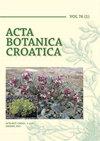Preliminary characterization of the Quercus pubescens complex in southern Italy using molecular markers
IF 0.7
4区 生物学
Q3 PLANT SCIENCES
引用次数: 13
Abstract
Quercus pubescens s.l. is a group of taxonomically intricate and highly debated deciduous white oaks widely distributed in southern Europe. The Apulia Region occupies the south-easternmost part of the Italian peninsula; the land-use pattern is based on extensive agricultural systems and only 10% is covered by forests that are mainly composed of oak woods. It is the region in Italy showing the highest number of oak species, among which four putative species of the Quercus pubescens group, have been reported in floras and checklists with uncertain taxonomic value because of the overlapping of diagnostic characters. In this paper, we carried out a molecular analysis on natural populations of Q. pubescens s.l. distributed throughout the Apulian region. Individuals from 24 pubescent oak populations were sampled and each tree was genotyped at 11 polymorphic microsatellite markers. Overall, the average expected heterozygosity (He) was 0.629, and the allelic richness (Ar) ranged between 2.130 and 7.187. No differentiation was observed among the populations investigated, and the genetic differentiation coefficient (FST) was 0.036. Gene flow among populations was found to be relatively high (Nm = 6.664). From a taxonomic point of view, the possibility of the coexistence of more than one species among the Apulian pubescent oaks reported in the taxonomic and syntaxonomic literature is not supported by the results of this molecular analysis.意大利南部短毛栎复合体的分子标记初步鉴定
毛栎是一组在分类学上复杂且备受争议的落叶白栎,广泛分布于南欧。阿普利亚大区位于意大利半岛的最东南部;土地利用模式以广泛的农业系统为基础,只有10%的土地被主要由橡树组成的森林覆盖。它是意大利橡树物种数量最多的地区,其中四种被认为是毛栎属的物种,由于诊断特征的重叠,在植物区系和清单中被报道具有不确定的分类价值。本文对分布在阿普利亚地区的毛白杨自然种群进行了分子分析。对来自24个青春期橡树种群的个体进行取样,并用11个多态微卫星标记对每棵树进行基因分型。总体而言,平均预期杂合度(He)为0.629,等位基因丰富度(Ar)在2.130至7.187之间。在所调查的群体中没有观察到分化,遗传分化系数(FST)为0.036。种群之间的基因流动相对较高(Nm=6.664)。从分类学的角度来看,分类学和句法组学文献中报道的阿普利亚青春期橡树中存在多个物种共存的可能性不受该分子分析结果的支持。
本文章由计算机程序翻译,如有差异,请以英文原文为准。
求助全文
约1分钟内获得全文
求助全文
来源期刊

Acta Botanica Croatica
PLANT SCIENCES-
CiteScore
2.50
自引率
0.00%
发文量
34
审稿时长
>12 weeks
期刊介绍:
The interest of the journal is field (terrestrial and aquatic) and experimental botany (including microorganisms, plant viruses, bacteria, unicellular algae), from subcellular level to ecosystems. The attention of the Journal is aimed to the research of karstic areas of the southern Europe, karstic waters and the Adriatic Sea (Mediterranean).
 求助内容:
求助内容: 应助结果提醒方式:
应助结果提醒方式:


